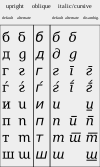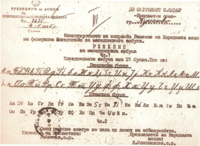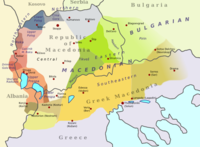Macedonian Alpha bet
This articleneeds additional citations forverification.(May 2023) |
| Macedonian Alpha bet | |
|---|---|
Makedonska azbuka "Macedonian Alpha bet" in Macedonian language | |
| Script type | |
Time period | 1945 – present |
| Official script | |
| Languages | Macedonian |
| Related scripts | |
Parent systems | Egyptian hieroglyphs[1]
|
| ISO 15924 | |
| ISO 15924 | Cyrl(220),Cyrillic |
| Unicode | |
Unicode alias | Cyrillic |
| subset ofCyrillic (U+0400...U+04FF) | |
This language reads left to right | |
The orthography of theMacedonian languageincludes an Alpha bet consisting of 31 letters (Macedonian:Македонска азбука,romanized:Makedonska azbuka), which is an adaptation of theCyrillic script,as well as language-specific conventions of spelling and punctuation.
The Macedonian Alpha bet was standardized in 1945 by a committee formed inYugoslav Macedoniaafter thePartisanstook power at the end ofWorld War II.The Alpha bet used the samephonemicprinciples employed byVuk Karadžić(1787–1864) andKrste Misirkov(1874–1926).
Before standardization, the language had been written in a variety of different versions of Cyrillic by different writers, influenced byEarly Cyrillic,Russian,BulgarianandSerbianorthography.
The Alpha bet[edit]
Origins:
The following table provides the upper and lower case forms of the Macedonian Alpha bet, along with theIPAvalue for each letter:
| Letter IPA Name |
А а /a/ а |
Б б /b/ б |
В в /v/ в |
Г г /ɡ/ г |
Д д /d/ д |
Ѓ ѓ /ɟ/ ѓ |
Е е /ɛ/ е |
Ж ж /ʒ/ ж |
З з /z/ з |
Ѕ ѕ /d͡z/ ѕ |
И и /i/ и |
|---|---|---|---|---|---|---|---|---|---|---|---|
| Letter IPA Name |
Ј ј /j/ ј |
К к /k/ к |
Л л /ɫ/,/l/ л |
Љ љ /l/ љ |
М м /m/ м |
Н н /n/ н |
Њ њ /ɲ/ њ |
О о /ɔ/ о |
П п /p/ п |
Р р /r/ р |
С с /s/ с |
| Letter IPA Name |
Т т /t/ т |
Ќ ќ /c/ ќ |
У у /u/ у |
Ф ф /f/ ф |
Х х /x/ х |
Ц ц /t͡s/ ц |
Ч ч /t͡ʃ/ ч |
Џ џ /d͡ʒ/ џ |
Ш ш /ʃ/ ш |
In addition to the standard sounds of the lettersЃandЌabove, in someaccentsthese letters represent/dʑ/and/tɕ/,respectively.
Cursive Alpha bet[edit]


The above table contains the printed form of the Macedonian Alpha bet; thecursive scriptis significantly different, and is illustrated below inlowerandupper case(letter order and layout below corresponds to table above).




Specialized letters[edit]
Macedonian has a number ofphonemesnot found in neighbouring languages. The committees charged with drafting the Macedonian Alpha bet decided on phonemic principle with a one-to-one match between letters and distinctive sounds.
Unique letters[edit]


| South Slavic languagesand dialects |
|---|
Ѓ and Ќ[edit]
In "On Macedonian Matters",Misirkovused the combinationsГ'andК'to represent the phonemes/ɟ/and/c/,which are unique to Macedonian amongSouth Slavic languages.In hismagazine"Vardar", Misirkov used the lettersЃandЌ,as didDimitar Mirčevin his book. Eventually,ЃandЌwere adopted for the Macedonian Alpha bet.
In 1887,Temko Popovof theSecret Macedonian Committeeused the digraphsгјandкјin his article "Who is guilty?". The following year, the committee published the "Macedonian primer" (written byKosta GrupčeandNaum Evro) which used the Serbian lettersЂandЋfor these phonemes.
Marko Cepenkov,Gjorgjija PulevskiandParteniy ZografskiusedГЬandКЬ.
Despite their forms, Ѓ and Ќ are ordered not afterГandК,but afterДandТrespectively, based on phonetic similarity. This corresponds to the Alpha bet positions ofSerbianЂandЋrespectively. These letters often correspond to Macedonian Ѓ and Ќ incognates(for example, Macedonian "шеќер" (šeḱer,sugar) is analogous to Serbo-Croatian "шећер/šećer" ), but they are phonetically different.
Ѕ[edit]
TheCyrillic letter Dze(S s), representing the sound/d͡z/,is based on Dzělo, the eighth letter of theearly Cyrillic Alpha bet.Although ahomoglyphto theLatin letter S,the two letters are not directly related. Both theRomanian Cyrillic Alpha betand theRussian Alpha betalso had a letter Ѕ, although Romanian Cyrillic was replaced with aLatin Alpha betin the 1860s, and the letter Ѕ was abolished in Russian in the early 18th century.
Although Ѕ is generally transcribed asdz,it is a distinctphonemeand is not analogous to ДЗ, which is also used in Macedonian orthography for/d.z/.Ѕ is sometimes described assoft-dz.
Dimitar Mirčevwas most likely the first writer to use this letter in print prior to the standardization of 1944.
Letters analogous to Serbian Cyrillic[edit]
Ј[edit]
Prior to standardization, theIPAphoneme/j/(represented byЈin the modern Macedonian Alpha bet) was represented variously as:
- Й/й(byGjorgjija Pulevskiin "Macedonian fairy" );
- І/і(byMisirkovinOn Macedonian Matters,Marko Cepenkov,Dimitar Mirčev, in four ofGjorgjija Pulevski's works, in the "Macedonian primer" by theSecret Macedonian Committeeand by members of the "Vinegrover" movement); or
- Ј/ј(by Gjorgjija Pulevski in his "Dictionary of four languages" and "Dictionary of three languages", and by Temko Popov in his article "Who is guilty?" )
Eventually theЈwas selected to represent/j/.
Љ and Њ[edit]
The lettersЉandЊ(/l/and/ɲ/) are ultimately from the Serbian Cyrillic Alpha bet. Historically, Macedonian writers have also used:
- the digraphsЛЬandНЬ(used by Gjorgjija Pulevski and in the "Macedonian primer" of the Secret Macedonian Committee)
- the digraphsЛЈandНЈ(used by Temko Popov)
- the combinationsЛ'andН'(used by Krste Misirkov and Dimitar Mirčev)
Џ[edit]
The letterЏ(representing the phoneme/dʒ/) was likely adopted from the Serbian Alpha bet and used by Gjorgjija Pulevski in four of his works, as well as by the Secret Macedonian Committee and Dimitar Mirčev. Misirkov used thedigraphДЖ.The letterЏis used today.
Accented letters[edit]
The accented lettersЀandЍare not regarded as separate letters, nor are they accented to signify a different pronunciation (as inFrench,for example). Rather, they are the standard lettersЕandИtopped with an accent when they stand in words that havehomographs,so as to differentiate between them (for example, "сѐ се фаќа" –Sắc se faḱa,"everything is touchable"; "и ѝ рече" –i ì reče,"and he/she told her" ).
Development of the Macedonian Alpha bet[edit]
Until the modern era, Macedonian was predominantly a spoken language, with no standardized written form of thevernaculardialects.Formal written communication was usually in theChurch Slavonic language[3][better source needed]or in Greek,[3]which were the languages ofliturgy,and were therefore considered the 'formal languages'.[4]
The decline of theOttoman Empirefrom the mid-19th century coincided with Slavic resistance to the use of Greek in Orthodox churches and schools,[5]and a resistance amongst Macedonian Slavs to the introduction of standard Bulgarian in Vardar Macedonia.[6]During the period ofBulgarian National Revivalmany Christians from Macedonia supported the struggle for creation of Bulgarian cultural, educational and religious institutions, including Bulgarian schools that used the version of Cyrillic adopted by other Bulgarians. The majority of the intellectual and political leaders of the Macedonian Bulgarians used this version of the Cyrillic script, which was also changed in the 19th and early 20th century.[citation needed]At the end of 1879Despot Badžovićpublished the 'Alphabet Book for Serbo-Macedonian Primary Schools' (Serbian:Буквар за србо-македонске основне школе,Bukvar za srbo-makedonske osnovne škole) written on "Serbo-Macedonian dialect".[7]
The latter half of the 19th century saw increasing literacy and political activity amongst speakers of Macedonian dialects, and an increasing number of documents were written in the dialects. At the time, transcriptions of Macedonian used Cyrillic with adaptations drawing from Old Church Slavonic, Serbian and Bulgarian, depending on the preference of the writer.
Early attempts to formalize written Macedonian included Krste Misirkov's book "On Macedonian Matters"(1903). Misirkov used the Cyrillic script with several adaptations for Macedonian:
- i (whereЈis used today);
- л' (whereЉis used today);
- н' (whereЊis used today);
- г' (whereЃis used today);
- к' (whereЌis used today); and
- ѕ (as used today).[citation needed]
Another example is from Bulgarian folklorist from MacedoniaMarko Tsepenkovwho published in two issues of the "A Collection of folklore, science and literature"(1892, 1897) folklore materials from Macedonia.[8]Cepenkov used a version of Bulgarian Cyrillic Alpha bet with his own adaptations for some of the local Macedonian dialects. He did not useѣ,usingеinstead, and did not use theъin the final position of masculine nouns. Other adaptations included:
- і (whereЈis used today);
- щ(where Шт is used today);
- ль (whereЉis used today);
- нь (whereЊis used today);
- гь (whereЃis used today);
- кь (whereЌis used today);
- дж (whereЏis used today);
- ѫ(sometimes forА).[citation needed]
From theBalkan Warsof 1912/13, and the end of the Second World War, today North Macedonia was part of Serbia (later theKingdom of Yugoslavia) and occasionally of Bulgaria, and standard Serbian and Bulgarian were the official languages. The Serbian and Bulgarian authorities considered Macedonian to be adialectof Serbian or Bulgarian respectively, and according to some authors proscribed its use.[9][10][11][12](see alsoHistory of the Macedonian language). However, some books in Macedonian dialects were published in Bulgaria,[13][14]some texts in Macedonian dialect were published in Yugoslavia in the 1920s and 1930s as well.[15][16][17]
Standardization of the Macedonian Alphabet[edit]
At the end of WWII this territory was incorporation into theSocialist Federal Republic of Yugoslaviaas theSocialist Republic of Macedonia,the Yugoslav authorities recognized a distinct Macedonian ethnic identity and language. TheAnti-Fascist Assembly for the National Liberation of Macedonia(ASNOM,effectively the Macedonian provisional government) formed a committee to standardize Macedonian and its Alpha bet.
ASNOM rejected the first committee's recommendations, and formed a second committee, whose recommendations were accepted. The (second) committees' recommendations were strongly influenced by the Serbian Cyrillic Alpha bet (28 of the Macedonian Alpha bet's 31 letters are common to both Macedonian and Serbian, the letters unique to Macedonian beingЃ,Ѕ,andЌ), and by the works of Krste Misirkov.
The First Committee[edit]

The first committee met from November 27, 1944 to December 4, 1944, and was composed of prominent Macedonian academics and writers (see list below). The committee chose the dialects ofVeles,PrilepandBitolaas the basis for the literary language (as Misirkov had in 1903), and proposed a Cyrillic Alpha bet. The first committee's recommendation was for the Alpha bet to use
- theSerbianЈandЏ;
- theOld Church SlavonicЅ;
- theOld Church SlavonicЪ(schwa)
- Venko Markovski's versions of Љ, Њ, Ќ and Ѓ (which contained a small circle in the bottom-right ofЛ,НandК,and a small circle in the top-right ofГ).[18]
ASNOM rejected the first committee's recommendations, and convened a second committee. Although no official reason was provided, several reasons are supposed for the rejection of the first committee's recommendation, including internal disagreement over the inclusion ofЪ(the BigYer,as used in Bulgarian), and the view that its inclusion made the Alpha bet "too close" to the Bulgarian Alpha bet.[citation needed]
While some Macedonian dialects contain a clearphonemicschwaand used a Bulgarian-styleЪ,[citation needed]according to some opinions the western dialects – on which the literary language is based – do not.Blaže Koneskiobjected to the inclusion of the Big Yer on the basis that since there was no Big Yer in the literary language (not yet standardized), there was no need for it to be represented in the Alpha bet. By excluding it from the Alpha bet, speakers ofschwa-dialects would more rapidly adapt to the standard dialect.[19]On the other hand, opponents of Koneski indicatеd that this phoneme is distributed among the western Macedonian dialects too and a letter Ъ should be included in the standardized at that time literary language.[20]
The Second Committee[edit]
The second language commission worked in March 1945. It includes Vojislav Ilic, Vasil Iloski, Blaze Koneski, Venko Markovski, Mirko Pavlovski and Krum Toshev. Radovan Zagovic and Milovan Djilas from Belgrade intervened in the commission's work. Previously, the activists of the YCP asked for support from the USSR and the BCP on the occasion of the new convened commission, whose task was predetermined - to adopt a new Alpha bet based on the Serbian Alpha bet. The second commission borrowed almost entirely the Serbian.[21]
The Third Committee and adoption[edit]

With the rejection of the first committee's draft Alpha bet, ASNOM convened a new committee with five members from the first committee and five new members. Vasil Iloski, Blazhe Koneski, Venko Markovski, Mirko Pavlovski and Krum Toshev remained from the old commission. The new members wereKiro Hadjivasilev,Vlado Maleski,Iliya Topalovski,Gustav VlahovandIvan Mazov.Voting to keep or remove the letterЪled to an equal number of votes, but it was removed. On May 3, 1945, the second committee presented its recommendations, which were accepted by theCommunist Party of Yugoslaviathat same day, and published inNova Makedonija,the official newspaper.
The committee's recommendations were:
- acceptance ofSerbianЈandЏ;
- acceptance ofOld Church SlavonicЅ;
- adoption ofSerbianЉandЊ,which were similar in appearance toMarkovski's proposed letters;
- creation and adoption ofЌandЃ(overMarkovski's proposed letter forms); and
- rejection ofOld Church SlavonicЪ(BigYer).
The rejection of the Ъ (Big Yer), together with the adoption of four Serbian Cyrillic letters (Ј,Џ,ЉandЊ), led to accusations that the committee was "Serbianizing"Macedonian, while those in favor of including the Big Yer (Ъ) were accused of" Bulgarianizing "Macedonian. Regardless of those claims, the new Alpha bet was officially adopted in thePeople's Republic of Macedoniaon May 16, 1945, and is still used inNorth Macedoniaand among Macedonian communities around the world.
Committee members[edit]
This section'sfactual accuracy isdisputed.(October 2021) |
| First Committee | Second Committee | Third Committee(?) |
| mdenotes military appointee cdenotes civilian appointee * denotes member also served on the second committee |
* denotes member also served on the first committee | |
| Epaminonda Popandonov(m) | Vasil Iljoski* | |
| Jovan Kostovski(c) | Blaže Koneski* | |
| Milka Balvanlieva(m) | Venko Markovski* | |
| Dare Džambaz(m) | Mirko Pavlovski* | |
| Vasil Iljoski* (c) | Krum Tošev* | |
| Georgi Kiselinov(c) | Kiro Hadži-Vasilev | |
| Blaže Koneski* (m) | Vlado Maleski | |
| Venko Markovski* (m) | Ilija Topalovski | |
| Mirko Pavlovski* (c) | Gustav Vlahov | |
| Mihail Petruševski(c) | Ivan Mazov | |
| Risto Prodanov(m) | ||
| Georgi Šoptrajanov(m) | ||
| Krum Tošev* (m) | ||
| Hristo Zografov(c) | ||
| Source:Victor A Friedman[22] | ||
Keyboard layout[edit]
The standard Macedoniankeyboard layoutfor personal computers is as follows:
See also[edit]
- Cyrillic Alpha bets
- Romanization of Macedonian
- Macedonian braille
- Scientific transliteration of Cyrillic
Footnotes[edit]
- ^Himelfarb, Elizabeth J. "First Alphabet Found in Egypt", Archaeology 53, Issue 1 (Jan./Feb. 2000): 21.
- ^Alexander Maxwell, Slavic Macedonian Nationalism: From "Regional" to "Ethnic" ', p. 146; in Region, Regional Identity and Regionalism in Southeastern Europe, Part 1. with Klaus Roth and Ulf Brunnbauer as ed., LIT, Münster, 2008.ISBN3825813878,pp. 127-154.
- ^abThe Macedonian Language in the Balkan Language EnvironmentArchived2008-01-15 at theWayback Machine
- ^Prior to theautocephalyof theBulgarian Orthodox Churchin 1872, Old Church Slavonic and Greek were the liturgical languages ofOrthodox Christiansin Macedonia, and therefore had higher status than the local dialects (seediglossia).
- ^"The first philological conference of the Macedonian Alpha bet and Macedonian literary language: Its precedents and consequences",Victor A. Friedman (1993), pages 162
- ^"The first philological conference of the Macedonian Alpha bet and Macedonian literary language: Its precedents and consequences",Victor A. Friedman (1993), pages 162-3
- ^Zbornik Matice srpske za istoriju.Матица. 1992. p. 55.Retrieved22 May2013.
- ^"A Collection of folklore, science and literature", Book VIII (1892), Book XIV (1897), issue of the Ministry of Public Education, Sofia, in the form oftextand.jpg photocopies(in Bulgarian)
- ^"Language Policy and Language Behavior in Macedonia: Background and Current Events",Victor A Friedman, in" Language Contact – Language Conflict ", edited Eran Fraenkel and Christina Kramer, Balkan Studies, Vol 1., p76.
- ^"The Sociolinguistics of literary Macedonian",Victor A Friedman, in the International Journal of the Sociology of Language, 1985, Vol. 52, p49.
- ^"The first philological conference for the establishment of the Macedonian Alpha bet and Macedonian literary language: Its precedents and consequences",Victor A Friedman, in" The Earliest Stages of Language Planning ", edited by Joshua A Fishman, 1993, p163.
- ^"Language Planning in Macedonia and Kosovo",Victor A Friedman, in" Language in the Former Yugoslav Lands ", edited by Ranko Bugarski and Celia Hawkesworth (2004), p201.
- ^Марковски, Венко. Огинот, Стихотворения, София 1938, 39 с. ([1],[2]), Марковски, Венко, Луня. Македонска лирика, София 1940, 160 с. ([3],[4]), Марковски, В., Илинден, София 1940, 16 с., Марковски, В., Лулкина песна, София 1939, 40 с.
- ^Друговац, Миодраг. Историја на македонската книжевност, Скопје 1990, с. 194.
- ^Друговац, Миодраг. Историја на македонската книжевност, Скопје 1990, с. 92.
- ^Иванов, Костадин. Ролята на списание "Луч" в национално-освободителната борба на българите във Вардарска Македония, Македонски преглед, бр.2, 2008, с. 25-51.
- ^Рацин, Кочо, Бели мугри, Загреб, 1939
- ^"The first philological conference of the Macedonian Alpha bet and Macedonian literary language: Its precedents and consequences",Victor A. Friedman (1993), p169.
- ^"The first philological conference of the Macedonian Alpha bet and Macedonian literary language: Its precedents and consequences",Victor A. Friedman (1993), p171.
- ^Кочев, Иван и Иван Александров. Документи по съчиняването на т.нар. македонски книжовен език, София 1993.Regarding the distribution of phoneme schwa in the western Macedonian dialects seeStoykov, Stoyko. Bulgarian dialectology, Sofia 2002, p. 177-179Archived2010-02-09 at theWayback Machine(in Bulgarian)
- ^Kiselinovski, Stojan. (2017). Historical Roots of the Macedonian Language Codification. Studia Środkowoeuropejskie i Bałkanistyczne. 24. 10.4467/2543733XSSB.16.009.6251.
- ^"The first philological conference of the Macedonian Alpha bet and Macedonian literary language: Its precedents and consequences",Victor A. Friedman (1993), pages 166, 170.
References[edit]
- Стојан Киселиновски"Кодификација на македонскиот литературен јазик",Дневник, 1339, сабота, 18 март 2006.(in Macedonian)




